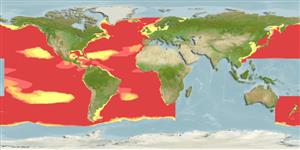Common names from other countries
>
Aulopiformes (Grinners) >
Paralepididae (Barracudinas)
Etymology: Magnisudis: Latin, magnus = large + Latin, sudis = esox, fish of the Rhine, cited by Plinius 9.15; it also means "stake" (Ref. 45335).
Environment: milieu / climate zone / depth range / distribution range
Ecología
marino; oceanodromo (Ref. 51243); rango de profundidad 0 - 4750 m (Ref. 58018). Deep-water; 69°N - 61°S, 180°W - 180°E
Circumglobal: From Arctic to Antarctic. Northwest Pacific: Bering Sea, Kamchatka and Kuril Islands (Ref. 41668). Eastern Pacific: southeast Alaska (59°N) to Chile (Ref. 35950). Western Atlantic: 38°N to the Gulf of Mexico, Bermuda, and the Caribbean Sea (Ref. 37039).
Tamaño / Peso / Age
Maturity: Lm ? range ? - ? cm
Max length : 56.0 cm SL macho / no sexado; (Ref. 557); common length : 43.0 cm SL macho / no sexado; (Ref. 4473)
Espinas dorsales (total) : 0; Radios blandos dorsales (total) : 9 - 12; Espinas anales: 0; Radios blandos anales: 20 - 24; Vértebra: 60 - 69. Branchiostegal rays: 8.
Oceanic species of medium depth range. Large adults approach the coasts in temperate and polar zones (Ref. 35950). Meso- and bathypelagic (Ref. 58302). Spawns throughout the year in tropical and subtropical seas (Ref. 35388). Seems to spawn in the Sargasso Sea. Feed on small fishes and shrimps. Preyed upon by sharks, tuna, and whales.
Life cycle and mating behavior
Maturities | Reproducción | Spawnings | Egg(s) | Fecundities | Larva
Post, A., 1990. Paralepididae. p. 373-384. In J.C. Quero, J.C. Hureau, C. Karrer, A. Post and L. Saldanha (eds.) Check-list of the fishes of the eastern tropical Atlantic (CLOFETA). JNICT, Lisbon; SEI, Paris; and UNESCO, Paris. Vol. 1. (Ref. 4473)
IUCN Red List Status (Ref. 130435)
CITES (Ref. 128078)
Not Evaluated
Threat to humans
Harmless
Human uses
Herramientas
Special reports
Download XML
Fuentes de Internet
Estimates based on models
Preferred temperature (Ref.
115969): 2 - 7.2, mean 3.8 (based on 2973 cells).
Phylogenetic diversity index (Ref.
82804): PD
50 = 0.6250 [Uniqueness, from 0.5 = low to 2.0 = high].
Bayesian length-weight: a=0.00224 (0.00090 - 0.00555), b=3.14 (2.92 - 3.36), in cm Total Length, based on LWR estimates for this (Sub)family-body shape (Ref.
93245).
Nivel trófico (Ref.
69278): 3.7 ±0.0 se; based on diet studies.
Fishing Vulnerability (Ref.
59153): Moderate to high vulnerability (47 of 100).
